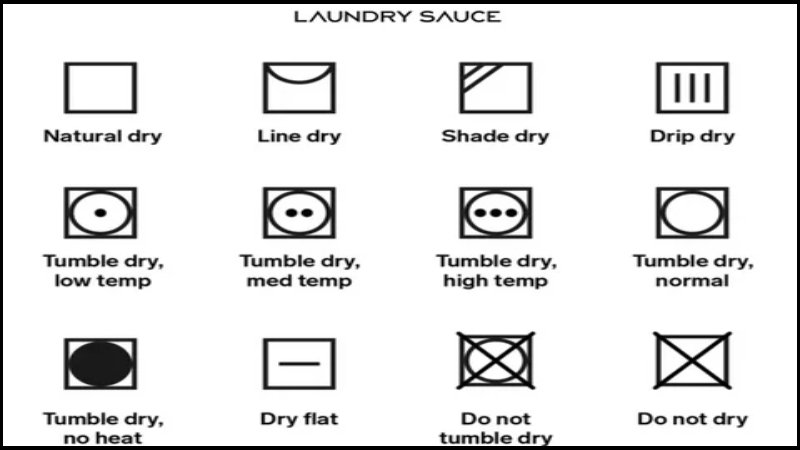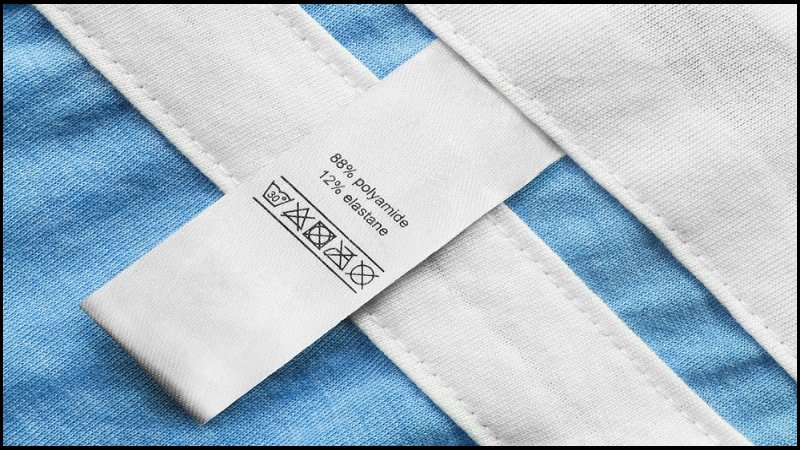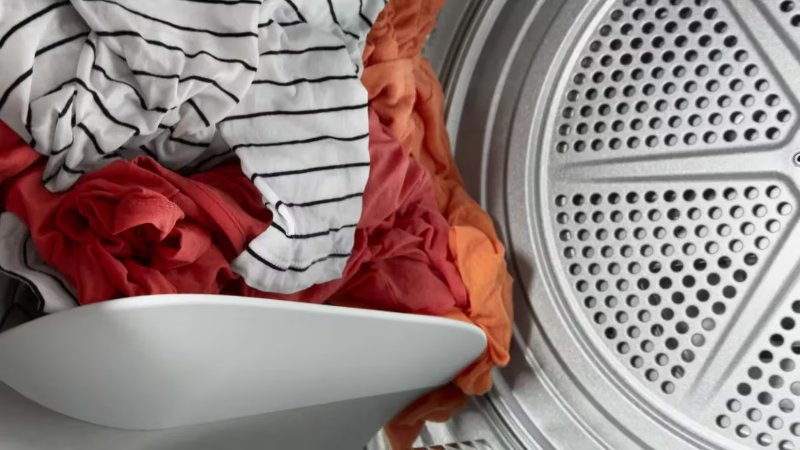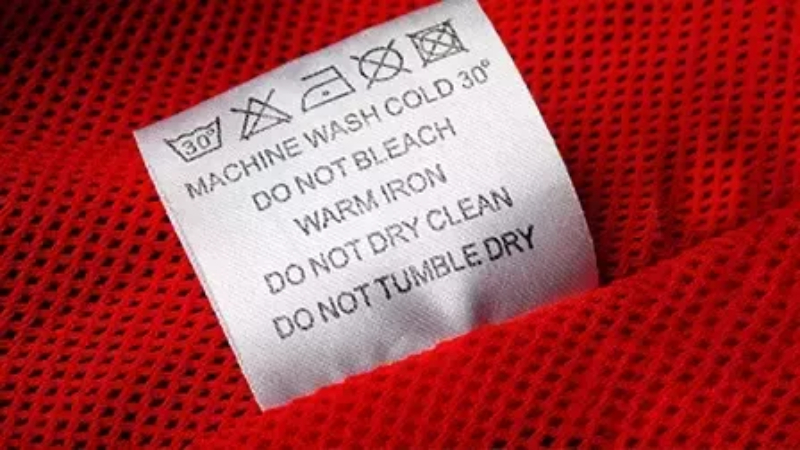Do Not Tumble Dry: Save Your Clothes From Damage
That little square with a circle and an “X” through it on your clothing’s care label is more important than you might think. It means “Do Not Tumble Dry,” and ignoring this instruction can lead to irreversible damage to your favorite garments.
This guide explains why tumble drying can be harmful to certain fabrics, helps you identify which items should never go in the dryer, and provides alternative drying methods to keep your clothes looking their best. Protecting your clothes starts with understanding your care labels.
1. Understanding the “Do Not Tumble Dry” Symbol
1.1 What Does the Symbol Look Like?
The “Do Not Tumble Dry” symbol is universally recognized and quite simple. It consists of a square with a circle inside, and a large “X” crossing through the circle. This visually represents a prohibition on using a tumble dryer.

1.2 Where Can You Find This Symbol?
This symbol is found on the care label or care tag attached to your clothing. This label is usually located inside the garment, often along a side seam, at the back of the neck, or along the waistband. The care label contains various laundry care symbols providing instructions for washing, drying, ironing, and dry cleaning.
1.3 International Variations
2. Why Can’t You Tumble Dry Some Clothes?
2.1 The Science of Heat and Fabric
Different fabrics react to heat in different ways. This is due to their unique fiber structures and properties:
- Natural Fibers (cotton, linen, wool, silk): Many natural fibers, particularly wool and silk, are highly hygroscopic, meaning they readily absorb moisture. When exposed to high heat in a dryer, these fibers can shrink, distort, or become damaged as the water molecules within them are rapidly removed.
- Synthetic Fibers (polyester, nylon, acrylic): While generally more resistant to shrinkage than natural fibers, some synthetics can be damaged by high heat. They may melt, become stiff, or lose their shape. The dimensional stability (ability to retain shape) of a fabric is a key factor.
- Blends: Fabrics made from a blend of natural and synthetic fibers will have properties of both. Their reaction to heat will depend on the blend ratio.
- Knit Fabrics: Can be easily stretched
2.2 Types of Damage Caused by Tumble Drying
Tumble drying can cause several types of irreversible damage to clothing:
- Shrinkage: This is the most common problem. Heat causes the fibers in the fabric to contract, making the garment smaller.
- Warping/Distortion: Heat and tumbling action can cause the fabric to lose its original shape, becoming twisted, stretched, or misshapen.
- Color Fading: High heat can accelerate color fading, especially in brightly colored or dark-colored garments.
- Embellishments: Heat can damage embellishments
- Damage to Delicate Fabrics: Delicate fabrics like silk, lace, and wool are particularly vulnerable to damage from heat and tumbling. The fibers can break, become matted, or lose their texture.

Tumble drying can cause several types of irreversible damage to clothing
2.3 Fabrics That Commonly Say “Do Not Tumble Dry
The following fabrics and garment types often have “Do Not Tumble Dry” instructions:
- Silk: Extremely delicate and prone to shrinkage and damage from heat.
- Wool: Can shrink dramatically and felt (become matted and dense) when exposed to heat and agitation.
- Rayon (Viscose, Modal): A semi-synthetic fiber that can shrink, stretch, or lose its shape when tumble dried.
- Lace: Delicate and easily snagged or torn by the tumbling action.
- Knit Fabrics: Can be easily stretched in tumble dry.
- Garments with embellishments: Sequins, beads, and other embellishments.
- Bras: The heat and tumbling can damage the elastic and shape of bras.
- Swimwear: The heat can damage the elastic and cause the fabric to lose its shape.
- Items with leather or suede trim: Heat can dry out and crack leather and suede.
3. How to Dry Clothes That Say “Do Not Tumble Dry
3.1 Air Drying: The Best Alternative
Air drying offers a significantly gentler alternative to machine drying. This method minimizes fabric stress, reducing the likelihood of shrinkage, color loss, and shape deformation, and is a more energy-efficient and environmentally responsible practice.
3.2 Different Air Drying Techniques
There are several ways to air dry clothes, depending on the garment type and your available space:
- Hang Drying: This is the most common method, suitable for many items and gently squeeze out excess water (do not wring). Smooth out any wrinkles. Use sturdy hangers that won’t rust or stain the fabric. Padded hangers are best for delicate items or knitwear to prevent shoulder bumps. Hang the garment on a clothesline, drying rack, or shower rod. Ensure there’s good air circulation around the item. Avoid direct sunlight for the long-term may fade the colors.
- Flat Drying: This method is essential for items that can stretch or lose their shape when hung, such as heavy sweaters or delicate knits. Use a drying rack designed for flat drying, or lay a clean, dry towel on a flat surface (like a table or countertop). Gently shape the garment and lay it flat on the prepared surface. Turn the garment over periodically to ensure even drying.

3.3 Tips for Faster Air Drying
Ensure good ventilation: Open windows or use a fan to improve air circulation around the drying clothes.
- Use a dehumidifier: A dehumidifier can help remove moisture from the air, speeding up the drying process.
- Space garments properly: Don’t overcrowd the drying rack or clothesline. Allow enough space between items for air to circulate.
- Use a high spin speed on your washing machine: (If appropriate for the fabric) A higher spin speed removes more water before drying, reducing drying time.
3.4 Can I put clothes that shouldn’t be tumble dried in the spin cycle of the washing machine?
Yes, you can. The spin cycle of the washing machine is used to remove excess water and does not generate heat.
4. The Benefits of Understanding Laundry Symbols (For Clothing Businesses)
For clothing businesses, understanding laundry symbols and educating customers about them is crucial for several reasons:
- Customer Education: Providing clear and accurate care instructions, including explanations of laundry symbols, empowers customers to care for their garments properly. This can lead to increased customer satisfaction and loyalty.
- Reduced Returns: When customers understand how to care for their clothes, they are less likely to damage them through improper washing or drying. This can lead to fewer returns and exchanges, saving the business time and money.
- Enhanced Brand Reputation: Demonstrating a commitment to garment care and customer education enhances the brand’s reputation as knowledgeable and trustworthy.
- Improved Customer Satisfaction: Garments that are properly cared for last longer and look better, leading to greater customer satisfaction.
- Opportunity for Upselling: Providing care instructions can be an opportunity to recommend related products, such as fabric conditioners or stain removers.
By incorporating laundry symbol information into product descriptions, care tags, and online content, clothing businesses can provide valuable guidance to their customers and build stronger relationships.

5. Related Questions
5.1 What if I accidentally tumble-dried something that says “Do Not Tumble Dry”?
Don’t panic! The consequences depend on the fabric and the heat setting. If the garment is still wet, remove it from the dryer immediately and air dry it. If it’s already dry, assess the damage. If it’s shrunk or misshapen, there’s unfortunately little you can do to reverse it. For minor shrinkage, you can try gently stretching the garment while it’s damp. For future reference, make it a habit to always check care labels before washing and drying.
5.2 Can I use a “low heat” setting on the dryer for “Do Not Tumble Dry” items?
No. The “Do Not Tumble Dry” symbol means that the garment should not be exposed to any heat from a tumble dryer, even a low setting. The combination of heat and tumbling action can still damage the fabric. Always opt for air drying when this symbol is present.
5.3 Is air drying always better than tumble drying?
While air drying is generally gentler on clothes and more energy-efficient, tumble drying does have some advantages. It’s much faster, and some items, like towels and bedding, can benefit from the fluffing action of a dryer. The key is to follow the care instructions on the garment label. If the label permits tumble drying, it’s generally safe to do so, using the appropriate heat setting.
5.4 How can I tell if my clothes are completely dry when air drying?
Feel the fabric. It should not feel cool or damp to the touch. Pay particular attention to thicker areas, like seams, waistbands, and cuffs. If you’re unsure, it’s always better to err on the side of caution and let the garment air dry for a bit longer.
Read more:
The “Do Not Tumble Dry” symbol is a vital piece of information on your clothing’s care label. Understanding this symbol, and the reasons behind it, is essential for protecting your garments from irreversible damage like shrinkage, warping, and color fading.
Air drying is the recommended alternative for items that should not be tumble dried, and there are various techniques you can use to air dry clothes effectively. By taking the time to read care labels and follow the instructions, you can significantly extend the life of your clothes and keep them looking their best. Make checking laundry symbols a regular part of your laundry routine – it’s a small effort that can make a big difference!























